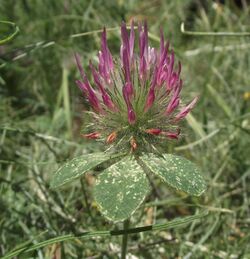Biology:Trifolium hirtum
| Trifolium hirtum | |
|---|---|

| |
| Scientific classification | |
| Kingdom: | Plantae |
| Clade: | Tracheophytes |
| Clade: | Angiosperms |
| Clade: | Eudicots |
| Clade: | Rosids |
| Order: | Fabales |
| Family: | Fabaceae |
| Subfamily: | Faboideae |
| Genus: | Trifolium |
| Species: | T. hirtum
|
| Binomial name | |
| Trifolium hirtum All.
| |
Trifolium hirtum, commonly known as rose clover, is a species of flowering plant in the legume family Fabaceae.[1][2] It is indigenous to a range of regions spanning Europe, Western Asia, and North Africa, and has been introduced to other parts of the world where it is cultivated for various purposes.
Distribution and habitat
Originally native to Europe, Western Asia, and North Africa, Trifolium hirtum has been introduced to other regions, including North America. In the United States, it was notably introduced to California from Turkey in the 1940s, initially as a forage crop to support animal agriculture. Today, it has become a widespread roadside weed in California, sometimes considered invasive, adapting well to the local climate and soil conditions.[3][4]
Morphology and anatomy
The plant is characterized as a hairy annual herb with an erect growth habit. Its leaves are trifoliate, featuring oval-shaped leaflets that measure up to 2.5 centimeters in length. Additionally, the leaves possess bristle-tipped stipules, adding to the plant's overall hairy appearance.
Inflorescence and flowers
The inflorescence of Trifolium hirtum is a head-like cluster of flowers, approximately 1.5 centimeters in diameter. Each individual flower consists of a calyx made up of sepals with elongated, needle-like lobes. These lobes may harden and become bristle-like as the plant ages. The calyces are covered in long, fine hairs, adding to the plant's hirsute character. The flower's corolla is pink in color and measures between 1 and 1.5 centimeters in length, adding a vibrant hue to the inflorescence.
Cultivation and uses
Rose clover is often cultivated as a cover crop, providing various ecological benefits such as soil stabilization and nitrogen fixation due to its leguminous nature. It is also utilized as animal fodder, particularly for grazing livestock like cattle and sheep. However, its widespread adoption has led it to become invasive in some areas, outcompeting native flora.
Ecological impact
While Trifolium hirtum has benefits as a cover crop and fodder, its introduction to non-native areas has sometimes led to it becoming invasive, potentially disrupting local ecosystems and outcompeting native plant species. Therefore, management practices may be needed to control its spread in certain contexts.
References
- ↑ "Trifolium hirtum". Natural Resources Conservation Service PLANTS Database. USDA. https://plants.usda.gov/core/profile?symbol=TRHI4. Retrieved 15 December 2015.
- ↑ (xls) BSBI List 2007, Botanical Society of Britain and Ireland, https://bsbi.org/download/3542/, retrieved 2014-10-17
- ↑ , Wikidata Q104828537
- ↑ , Wikidata Q104828538
External links
- Jepson Manual Treatment
- {{citation
| mode = cs1 | title = Trifolium hirtum | work = Germplasm Resources Information Network (GRIN) | url = | publisher = [[Organization:Agricultural Research ServAgricultural Research Service (ARS), United States Department of Agriculture (USDA) | access-date = }}
Wikidata ☰ Q253477 entry
 |

